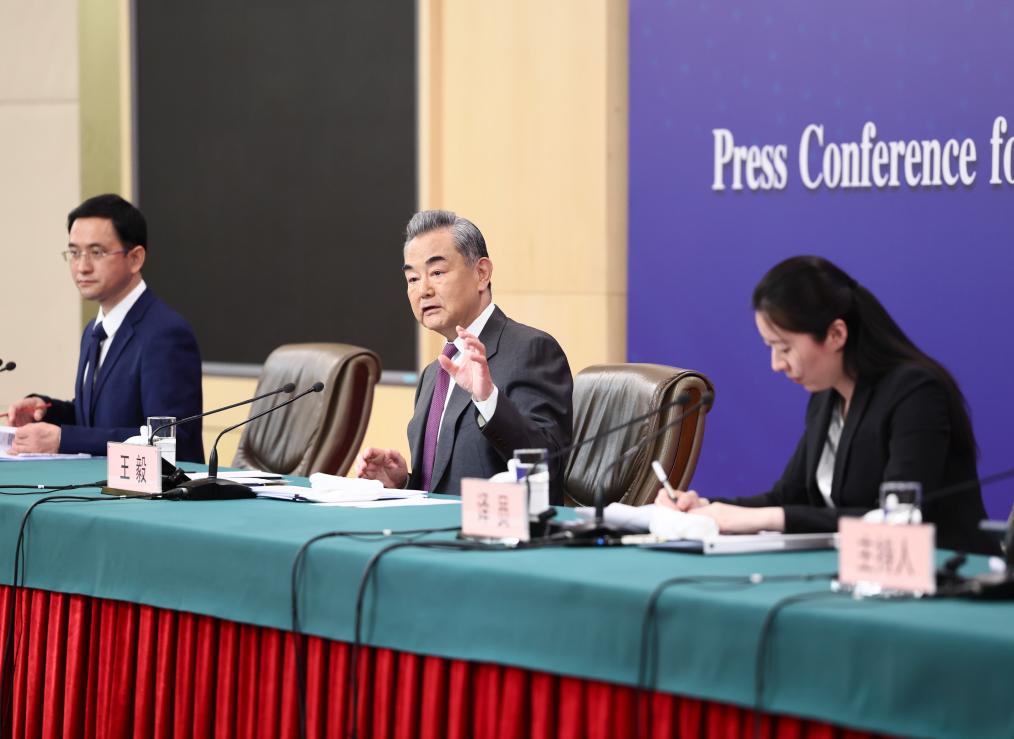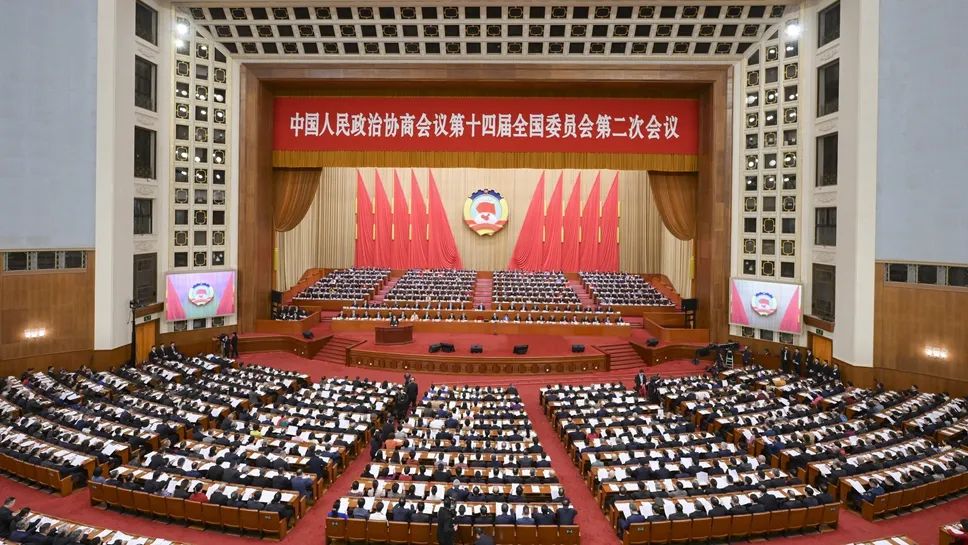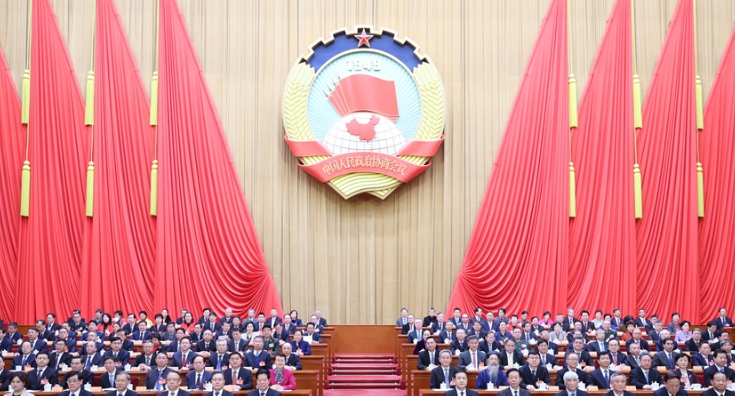
三级笔译实务第四讲文稿
翻译鉴赏部分:
刘晓明大使在英国国防大学联合指挥与参谋学院的演讲:《孙子兵法》与中国的外交国防政策
尊敬的联合指挥与参谋学院院长洛克空军少将,
女士们、先生们,
未来的将军们:
我很高兴应洛克院长的邀请访问英国国防大学联合指挥与参谋学院,这座将军的摇篮。
我曾在英国许多大学发表过演讲,包括牛津、剑桥、帝国理工等。今天还是第一次在英国军事院校作演讲。洛克院长为今天的演讲出了好几个题目,包括中国的外交、国防政策和中欧、中英关系。
既然是在军事院校演讲,我不妨从中国古代的一部兵书谈起,这就是著名的《孙子兵法》。《孙子兵法》已有2500年历史,被译成许多种语言,流传到世界各地,仅英文译本就有17种之多。虽然作为冷兵器时代的一部兵书,《孙子兵法》有些内容已经远离当今时代,但其许多战略、战术思想并未随历史褪色,而仍熠熠生辉。美国西点军校将之列为必读经典。英国著名军事历史学家和军事理论家利德尔•哈特(Sir B H Liddell—Hart)曾经深入研究过《孙子兵法》,并在为Samuel Griffith的《孙子兵法》英译本作序时认为《孙子兵法》远未过时,并感叹道:“《孙子兵法》将我20多部著作所涉及的战略和战术原则几乎包罗无遗。
”
我发现,《孙子兵法》对今天中国外交、国防政策的形成亦有深刻影响。
《孙子兵法》开宗明义第一句话,就是:“兵者,国之大事,死生之地,存亡之道,不可不察也。” 孙子还认为, “故上兵伐谋,其次伐交,其次伐兵,其下攻城。”可见,《孙子兵法》尽管是一部兵书,但其指导思想是“慎战”和“不战”。这与中国古代其他先哲的观点如出一辙,如老子和孟子都认为:“兵者,凶器也。”这也就不难理解90年前为什么英国著名哲学家、思想家罗素在其著作《中国问题》中指出:“中国历史上虽然征战连绵,但中国人天性是喜好和平的。”
《孙子兵法》及中国古代的这些和平、不战思想,是今天中国和平发展道路的滥觞。
今天的中国,立足中国国情,顺应时代潮流,坚持独立自主的和平外交政策,将维护世界和平、促进共同发展作为中国外交政策的宗旨。中国倡导互信、互利、平等、协作的新安全观,秉持积极有为的国际责任观,奉行睦邻友好的地区合作观,主张世界各国一道建立持久和平、共同繁荣的和谐世界。中国绝不搞侵略扩张,永远不争霸、不称霸,始终作维护世界和地区和平稳定的坚定力量,中国绝不走历史上“国强必霸”的老路。
今天的中国,坚定支持联合国在维护世界和平与安全中的核心地位,致力于和平解决国际争端和热点问题。中国是唯一公开承诺不首先使用核武器、不对无核武器国家和无核武器区使用或威胁使用核武器的核国家。中国累计向联合国30项维和行动派出各类人员约2.1万人次,是派出维和人员最多的联合国安理会常任理事国。中国积极参与反恐、防扩散领域国际合作,向索马里海域派遣海军护航编队。中国在朝核、伊朗核等热点问题上坚持劝和促谈,推动形成朝核问题六方会谈机制,发挥了建设性作用。中国同12个陆地邻国解决了历史遗留的边界问题,坚持通过对话谈判处理同邻国领土和海洋权益争端,提出“搁置争议、共同开发”的主张,尽最大努力维护南海、东海及周边和平稳定。
不久前,我在接受BBC“新闻之夜”节目采访时,主持人杰里米•帕克斯曼问我:“美国为了推行民主不惜发动战争。中国想推行什么?”我当时就回答说:“中国致力于构建和谐世界。我们主张国与国相互尊重、相互包容,而不是把自己的价值观和社会制度强加给别人。我们主张世界各国携手努力,保障各国共同安全与福祉,维护世界和平与稳定。我们坚决反对在国际事务中诉诸武力。”这就是中国的和平外交政策。
与中国的和平外交政策相一致,今天中国奉行的是防御性国防战略。《孙子兵法》是一部兵书,是战争的艺术,那么战争的最高境界是什么?孙子认为是“百战百胜,非善之善者也;不战而屈人之兵,善之善者也。”孙子也提出:“非危不战”,“无恃其不来,恃吾有以待之;无恃其不攻,恃吾有所不可攻也”。
只有建立强大的国防,才能有效维护国家主权安全和发展利益;只有具备制胜的力量,才能有效地遏制战争,这是古今中外历史告诉我们的真理。中国有广阔的领土和辽阔的海洋,面对错综复杂的国际战略格局和中国安全环境,面对世界新军事变革方兴未艾的发展态势,能否化解多元和复杂的非传统安全挑战,能否有效应对暴力恐怖势力、民族分裂势力和宗教极端势力的威胁,能否打赢未来可能发生的高技术战争,成为中华民族能否实现伟大复兴的关键。
中国的国防建设不针对、不威胁任何国家,中国不会也无意同任何国家搞军备竞赛。中国的国防建设从来没有超越捍卫国家安全的需要,中国国防开支也是合理适度的。根据伦敦国际战略研究所的报告,中国的军费在世界各国中处于较低水平,2010年中国军费占GDP的1.3%,不仅远低于美国、英国、俄罗斯等传统军事强国,也低于印度、巴西等新兴国家。如果从人均军费看,中国则更低,仅有美国的1/38,英国的1/20。
《孙子兵法》从根本上主张不战、慎战,但并不惧战、畏战。同样,我们讲积极防御,并不是软弱可欺,而是后发制人。后发即“人不犯我、我不犯人”,制人则是“人若犯我、我必犯人”。中国积极防御军事战略的立足点,是有效遏制和防止战争,同时也是时刻准备应对战争和打赢战争。以敢战能战来达到不战而屈人之兵,以敢于“亮剑”而全力争取战争胜利,这是孙子兵法的精髓,也是当代中国的军魂。
女士们、先生们,
在当今世界,中欧关系是很重要的双边关系。中国是世界上最大的发展中国家,欧洲是世界上最大的发达国家集合体,中欧之间没有地缘政治争端,没有根本利害冲突。近几十年来,合作一直是双边关系的主流。中欧现在互为最大经贸合作伙伴。欧盟是中国第一大出口市场,中国是欧盟第二大出口市场,欧盟还是中国第一投资目的地和最大技术引进来源地。
中英关系的发展总体上与中欧关系步调保持一致。中英高层互访密切频繁,经贸合作亮点频现,人文交流热度频升。今年是中英建立大使级外交关系40周年,两国将举行一系列纪念庆祝活动。特别值得指出的是,中英两军关系近年来也走上快速发展轨道。去年,英军陆、海、空军参谋长相继访华。中英防务战略磋商和两国高级退役将领交流得到机制化。
如何进一步发展中欧、中英关系?我仍想借用《孙子兵法》及中国古人的一些智慧。
《孙子兵法》里有一句名言:“知己知彼,百战不殆”。《孙子兵法》总共只有6074个字,其中“知”字是出现频率最多的一个字,共出现了79次。今天,中欧关系及中英关系是合作伙伴关系,不是竞争对手关系,要发展和深化这种伙伴关系,就要不断加深了解,增强信任,化解疑虑,消除担忧。我想在此引用你们的一位前辈的观点,他就是曾任英军陆军野战部队司令的拉姆中将。去年,他作为英国退役将军代表团团长访问了中国,回来后在《泰晤士报》上发表了一篇文章,他在文章中认为,欧洲和西方不能制造新的敌人,不能妖魔化中国,对话有益彼此了解,驱除担忧。
中国古语说:“尺有所短,寸有所长;物有所不足,智有所不明。”中欧、中英处在不同的发展阶段,面临着不同的发展挑战,彼此经济互补性强,合作利益大,双方应当充分拓展合作空间,挖掘合作潜力,努力实现互利共赢。
中欧、中英的历史文化、社会制度和价值观念不同,双方在一些问题上存在分歧是正常的。如何对待这些不同?如何处理这些分歧?我们不赞成将自己的制度视为普世模式,到处推销;不赞成将自己的价值观视为唯一正确标准,强加于人;也不赞成冷战思维,搞意识形态对抗。我们主张双方相互尊重,正视不同,平等相待;坦诚对话,求同存异,增进互信;相互借鉴,取长补短,互利共赢。
《孙子兵法》里还有一个著名的故事,讲得是中国古时候吴国人与越国人不和,当他们同船渡河时,遇到大风,他们相互救援就像人的左右手一样。这个故事成为了一句成语——“同舟共济”。
在世界多极化、经济全球化、社会信息化深入发展的时代,世界是一个“地球村”。恐怖主义、大规模杀伤性武器扩散、自然灾害、气候变化、公共卫生、金融风险以及能源资源、粮食和水资源安全,是全球性问题和人类共同挑战;同时,中欧利益相互依存、利益交融,实际上形成了你中有我、我中有你的命运共同体,也就是说欧洲和中国同在一条船上。中欧必须同舟共济、携手合作,努力实现可持续和包容性发展。
女士们、先生们:
今天中国的外交和国防政策,是历史积淀、时代发展和博采众长的产物,显然一部《孙子兵法》不足以概括全部,但我相信,认识《孙子兵法》这部古老的兵书,了解中国思想文化的源头,能为理解今天中国的和平发展道路增添一条途径,能为打消对中国的不必要担忧增加一些决心,能为积极开展与中国的交流合作增强一些动力。这就是我今天演讲的主旨所在。
谢谢!
Sun Tzu's Wisdom Behind China's Diplomacy and Defence Policy
Speech by H.E. Ambassador Liu Xiaoming At the UK Joint Services Command and Staff College
Air Vice-Marshal Ray Lock,
Ladies and Gentlemen,
Commanders of the Future,
It’s my great pleasure to visit the Joint Services Command and Staff College.
I was delighted to accept the invitation of Air Vice-Marshal Ray Lock to give this talk.
I’ve visited and spoken at many British universities, such as Oxford, Cambridge and Imperial College. But today is unique in the sense that this is my first speech to a military college.
I am impressed to know that your College has won a reputation as the cradle of military leaders for Britain.
I feel privileged to speak and propose to touch on three themes:
• China’s diplomacy;
• China’s defence policy;
• And China’s relations with Britain and Europe.
We need to take a step back to understand China’s foreign and defence policy. Since this is a military college, let’s trace the origin of Chinese thinking on war and peace.
The key is an ancient Chinese book.
Sometime it is called ‘Military Principles’ but the more popular translation is The Art of War.
This is a classical Chinese military treatise written 2,500 years ago. The book was authored by a high-ranking general called Sun Tzu.
The book has since been translated into many languages and read and studied around the world. It is said there are 17 English versions.
You might ask what relevance such an ancient book has in the high technology world of today. Some arguments in The Art of War do seem to be out of touch in the modern world.
But with careful study you will find that many of its strategies, tactics and thoughts are highly relevant today. The book still offers a central text of military thought for defense communities. I know that the book has been adopted as a must-read by West Point and many other military academies.
The prominent British military historian and theorist Sir Basil Liddell Hart was a student of The Art of War. He argued the book was far from outdated.
In his foreword for Samuel Griffith’s English translation of the book, he wrote:
“It was time they went back to Sun Tzu, since in that one short book was embodied almost as much about the fundamentals of strategy and tactics as I had covered in more than twenty books.”
For China, the importance of The Art of War has spread far beyond military studies. The book has deep influence in framing China’s foreign policy and its approach to security and defence.
The opening line of The Art of War is:
“The art of war is of vital importance to the State. It is a matter of life and death, a road either to safety or to ruin.
Hence it is a subject of inquiry, which can on no account be neglected.”
Sun Tzu continued:“Thus the highest form of generalship is to balk the enemy’s plan. The next best is to prevent the junction of the enemy’s forces. The next in order is to attack the enemy’s army in the field. And the worst policy of all is to besiege walled cities.”
The Art of War stands out from other military theory books. The reason is the stress on the cautious use of force and to avoid war.
Sun Tzu is not alone in this view.
Many Chinese philosophers around his time also cautioned against war. Both Lao Tzu and Mencius warned war and conflict carry big dangers.
There have also been thinkers outside China that support this approach. The famous British philosopher, Bertrand Russell, also observed the consistent commitment to peace of China. 90 years ago Russell wrote in his book The Problem of China that:
“Although there have been many wars in China, the natural outlook of the Chinese is very pacifistic.”
This legacy explains China’s choice of a peaceful path to development today. These are the key facts about our foreign and defence policies:
• China’s commitment to an independent, peaceful foreign policy is based upon its national conditions. This reflects the needs of our time.
• At the heart of our policy is to build a peaceful world that provides shared prosperity for all.
• China calls for mutual trust, mutual benefit, equality and cooperation to build a peaceful world.
• China actively assumes its fair share of global responsibilities and seeks to shape a friendly neighborhood.
• We want to work with all countries and contribute to a harmonious world of lasting peace and common prosperity.
• China does not believe in expansion or hegemony.
• Instead, we have always been a staunch force for world peace and regional stability.
• China will not repeat the errors of history, whereby ‘power leads to hegemony’. That approach has plunged the world into disaster and conflict.
• China supports the centrality of the United Nations in matters affecting world peace and security.
• China is committed to addressing international disputes and related crisis in a peaceful manner.
• China is the only country that has publicly undertaken not to be the first to use nuclear weapons. In addition China will not use, or threaten to use, nuclear weapons against non-nuclear countries or nuclear-free zones.
• China is the largest peace keeping contributor within the UN Security Council. We have sent 21,000 peacekeepers on 30 UN missions.
• China plays an active role in international counter-terrorism and non-proliferation. Currently, our naval vessels are performing escort missions in the waters off Somalia.
• China encourages peace talks on the North Korean nuclear issue. We are the host and a constructive participant in the Six-Party talks.
• The same approach applies to the Iranian nuclear issue and other critical conflicts.
• China has peacefully addressed its long-standing boundary issues with 12 of its neighbours on land. We are determined to find negotiated solutions to territorial and maritime disputes with neighbouring countries
• China is guided by the principle of ‘shelving disputes and joint development’. We will do everything we can to keep the South China Sea, the East China Sea and our entire neighborhood peaceful and stable.
Recently, I spoke about the peaceful, responsible role of China in world affairs. This was on BBC Newsnight. Jeremy Paxman asked me:
“The United States will go to war to promote democracy, what do you try to promote?”
I responded by saying:
“We are promoting a harmonious world. We believe the world will be more peaceful and prosperous, if all countries respect each other, rather than imposing their own ideas and systems onto others. We believe mutual respect, mutual accommodation and working together for the common good, common security is in the interest of peace and stability of the world. So we are strongly opposed to any military solutions.”
This is what China’s peaceful foreign policy is all about.
Consistent with this foreign policy guideline, China’s military posture is defensive in nature.
Let me explain our thinking by returning to The Art of War and ask this question:
If war is an art, then what is the highest level of victory?
Sun Tzu gives this answer:
“To fight and conquer in all your battles is not supreme excellence; supreme excellence consists in breaking the enemy’s resistance without fighting.”
To stress the war as the last resort for self-protection, Sun Tzu continues:
“Fight not unless the position is critical”.
Essentially Sun Tzu laid out a strategy of pro-active defence where he writes:
“The art of war teaches us to rely not on the likelihood of the enemy’s not coming, but on our own readiness to receive him; not on the chance of his not attacking, but rather on the fact that we have made our position unassailable.”
Only a strong and credible force of defence can effectively protect national sovereignty and development interests.
Only such a force can effectively deter any attempt for war. This is what the pattern of world history has taught us.
China has a huge landmass and vast waters under its jurisdiction.
We face a complex international strategic landscape and security environment. In addition a new revolution in military affairs is gaining momentum worldwide.
Going forward, the critical challenges for China are three-fold:
• Whether or not China can defeat diverse and complex non-conventional security challenges?
• Whether or not China can effectively deal with threats from violent terrorism, ethnic separatism and religious extremism?
• And whether or not China can win a high-tech war in the future?
The answers to these three questions determine whether China’s national rejuvenation is possible.
What I want to stress are these points:
• China’s defence modernisation doesn’t target or threaten any one.
• China has no interest or intention to engage in any arms race.
• China’s defence building never exceeds the need for national security.
• And China’s defence spending has always been reasonable and proportionate to the challenges we face.
These are key comparative facts about military spending:
• According to a report of the International Institute for Strategic Studies, China’s military budget is relatively low compared to other major powers.
• Our spending was only 1.3 percent of China’s GDP in 2010.
• This figure is below that of America, Britain, Russia.
• Also the 1.3 percent of GDP is lower than some emerging countries such as India and Brazil.
• At a per head level, China’s defence spending is even lower. We are only 1/38 of America and 1/20 of Britain.
In essence, The Art of War talks about avoiding war and going to war with caution. But, this prudent approach does not mean fear or cowardice.
It is crucial that leaders around the world understand our defence strategy. They should never mistake the principles of The Art of War as a display of weakness and vulnerability.
China is not to launch preemptive strikes. But in case we are threatened or under attack, there should be no doubt that China will take robust action to protect its interests.
The thrust of Chinese defence strategy is very clear. China has the deterrence and wisdom to win without fighting. But if needed, China has the courage and capability to win through fighting.
This is the essence of The Art of War and the soul of China’s military strategy today.
Ladies and Gentlemen,
I would also address the issue of China’s relations with Britain and Europe.
In today’s world, the China-Europe relationship carries much weight. China is the world’s largest developing country and Europe is by far the largest bloc of developed countries. We have no geopolitical tension or fundamental conflicting interests between us.
For decades, cooperation has been the defining feature of our relationship. Today, we are each other’s number one trading partner. To be specific, the EU is China’s largest export market, largest investment destination and the biggest technology supplier of China. And China is the EU’s second largest export market.
Turning to the relations between China and Britain.
China-UK relations are also growing fast. This is a partnership marked by mutual good-will, close high-level engagements, strong commercial ties and fast developing people-to-people exchanges.
This year, our two countries will co-host a range of celebrations to mark 40 years of full diplomatic relations.
In the context of this strengthening relationship, one particular area of good progress is our military-to-military ties.
Last year, Britain’s Chief of General Staff, Chief of Naval Staff and Chief of the Air Staff all paid visits to China.
China-UK defence strategic consultation and a structured dialogue between Chinese and British retired senior military officers have been put in place.
In this final part of my talk today I would like to pose the following question:
• Going forward, how to strengthen China’s relations with Britain and Europe?
Let me borrow some wisdom from The Art of War and China’s ancient sages.
The Art of War famously remarked:
“If you know your counterparts and know yourself, you will have nothing to fear.”
What merits much attention is that the book’s original Chinese text has 6,074 characters.
Within these characters the word ‘know’ appears 79 times. That is more than any other character.
Today, Europe and Britain are China’s partners, not adversaries. For our partnership to strengthen and widen, we need to know each other better. We need greater trust to disarm suspicions and concerns. Let me quote what one veteran British general said of China.
Lieutenant-General Sir Graeme Lamb is the former Commander Field Army. Last year he led a delegation of British veteran generals to China.
In The Times upon his return, he wrote these words:
“We should talk to China, not demonise it. … The danger lies in making a new enemy. …When it comes to relations with the Chinese, … it's good to talk. That applies to both sides. …Knowledge dispels fear.”
We Chinese have an old saying:
“Everything has its merits and demerits. And wisdom has its limits”.
The fact that China is at a different stage of development from Britain and Europe means we face different sets of challenges.
This also means we have much to gain from this strong economic complementarity and from cooperation.
Greater effort must be made to widen the scope of cooperation and to tap into the rich potentials to build a win-win future.
For this to happen, our different histories, cultures, social systems and values shouldn’t become barriers. The question is how we should handle differences and diversity.
Some people see their own system as universal and try to export it throughout the world. They see their own values as the only right standard, to which the whole world should be held up.
This is not what we would support. We are not in favour of imposing one’s own views on others, nor do we support Cold-War style ideological confrontation.
We believe in facing up to differences squarely, with respect and a shared commitment to seek common ground. Only in this way can we achieve win-win and both succeed through good-faith mutual learning.
Talking of solidarity and cooperation, there’s another well known story arising from The Art of War. The story is about Warring Kingdoms. The people from the Wu Kingdom and those from the Yue Kingdom did not like each other. But when paddling across the river during a storm, they would cooperate as the right hand does with the left.
From this story came a Chinese idiom:
‘Those sailing across the river in one boat should help each other.
In a multipolar world our society has become a global village. The driving forces of new technologies have shaped that globalisation.
In this globalised world collaboration is the only solution to shared challenges. Global challenges are with us daily, such as:
• Terrorism.
• WMD proliferation.
• Natural disasters.
• Climate change.
• Public health.
• Financial risks.
• Energy and resource scarcity.
• Food and water safety.
All these are challenges on a global scale and threaten all of us.
China and Europe are today interlinked and interdependent and have a shared destiny.
China and Europe must show solidarity and work together to achieve sustainable and inclusive development.
Ladies and Gentlemen,
China’s diplomacy and thinking on defence have deep roots in Chinese history. I have described how the ancient principles are highly relevant to the challenges of our time. China strengthens its approach by also absorbing the best ideas from other countries.
The Art of War certainly cannot capture all facets of China’s conduct of diplomacy and defence policy. But it’s my belief that this book provides a good beginning to understand Chinese thinking and culture.
I hope you will be inspired to study China more with the support of The Art of War. I believe if you follow this path you will grasp the value of China’s choice of peaceful development. This is also the road to dispel unfounded misgivings and add momentum for dialogue and cooperation.
As future military leaders from this prestigious college you have high responsibilities. As China rises, you will find my country more relevant within those responsibilities. So, I hope my thoughts today will inspire you to study China deeply.
In this way you can maximise the prospect of building a peaceful and harmonious world.
That is surely a shared goal of mutual interest for all our people.
Thank you!
英汉:
Princeton: river in autumn
普林斯顿:秋天里的河流
It’s now the autumn in New Jersey. I walked into the Nassau Hall this afternoon. Sunshine fell upon the old benches. It reminded me of the movie scene in which the aged John Nash was given pens. The wisdom here is like a serene river, flowing in colors of grey, green and orange. I’m writing with the pen you gave to me. (Princeton, 2007)
现在正是新泽西的秋天。今天下午,我去了拿莎堂。阳光斜照在古老的长椅上,让我想起了电影中年迈的约翰·纳什被人送上钢笔的一幕。这里的智慧像是一条平静沉缓的河流,映出斑驳的灰色、绿色和橙色。我正用你送我的笔写这张明信片。(普林斯顿,2007)
[校园导览]
Gray stone buildings at Princeton are pure Collegiate Gothic splendor. But the 500-acre campus’s beauty extends beyond their doors. Courtyards, idyllic greens, and crisscrossing footpaths dot the campus. The handsome ivy-covered Nassau Hall built in 1754 is the oldest building on campus.
普林斯顿大学的灰色石造建筑是纯正学院哥特风格的杰出代表,但500英亩校园的美景却不止于这些建筑,还有庭院、田园式绿地以及纵横的小径加以点缀。校园中历史最悠久的建筑是建于1754年的拿莎堂,它俊挺秀美,周身为长青藤所覆盖。
Virginia: freedom in breeze
弗吉尼亚:风中竞逐自由
“Liberty is the great parent of science and virtue.” I’m at the foot of Thomas Jefferson’s statue. Everything here has a Jeffersonian flavor, including the white flowers in front of the Rotunda. The summer breeze is free in the school founded by the man who drafted the Declaration of Independence. (Charlottesville, 2011)
“自由是科学和美德的伟大源泉。”我此时就在托马斯·杰斐逊的雕像脚下。这里的一切都有杰斐逊的味道,就连圆形殿前白色的花朵也是一样。他是《独立宣言》的起草者,也被尊为弗吉尼亚大学之父。此刻,迎面而来的夏日微风也无拘无束。(夏洛茨威尔,2011)
[校园导览]
Thomas Jefferson said his proudest achievement was creating the campus of the University of Virginia in 1819. Jefferson believed that real learning could only happen in an “academical village” setting, and toward that end, he designed the campus around an imposing rotunda with a lawn at its feet and 10 neo-classical pavilions (classrooms) lining the green.
托马斯·杰斐逊曾经说过,他最自豪的成就便是在1819年创建了弗吉尼亚大学。杰斐逊认为,真正的求知只可能发生在”学术村落”之中。为了实现这一想法,他把壮观的圆形殿放在中间,再衬以青葱的草坪。绿地两旁排开10栋新古典风的轩榭,作为先生们诲人不倦的场所。
Cornell: apples of wisdom
康奈尔:苹果树下的智者
The first week: I jumped into a pool in the local Fall Creek Gorge. It’s how the school welcomes freshmen. The 2nd week: I visited the plantations. Hu Shih once had a hard time dealing with Cornell’s apples, and left for studies in humanities. But I believe I am at a school where any person can find instruction in any study. (Ithaca, 2011)
入学第一周:我纵身跳进落溪谷中的深潭,这是康奈尔迎接新生的仪式。第2周:我去看了学校的种植园。据说,胡适曾在这里被苹果难倒,转而学文。不过我相信,这是任何人都能找到智者授业的地方。(伊萨卡,2011)
[校园导览]
The small town of Ithaca is the site of Cornell. The quaint New York town overlooks the picturesque Cayuga Lake. The campus has access to Fall Creek Gorge and Cascadilla Gorge, both of which provide spots for hiking and swimming. The university also owns a 2,800-acre botanical garden, Cornell Plantations.
名为伊萨卡的纽约小镇是康奈尔的所在之处。小镇古色古香,学校傍卡尤加湖而建,自有一派旖旎的风光。学校与当地的落溪峡谷和喀斯卡迪拉峡谷相连,两处都是远足、游泳的绝佳地点。另外,康奈尔还拥有2800英亩以学校名字命名的植物园。
Yale: tower for truth-seekers
耶鲁:攀登真理的梦之塔
I’m writing to you in a Yale library. The enormous books here are a tower restoring the truth. Many have climbed to reach the sky. They are the presidents walking out of Yale’s gates. Some are pilgrims from other lands. I’m one of those in this tower chasing a dream. (New Haven, 2010)
我在耶鲁的图书馆里写下这张明信片。这里数不清的藏书堆积成存真去伪的宝塔。登塔的人很多,有的到达了手可摘星的高处,他们就是从耶鲁走出来的总统们。这里还有不少远方来朝圣的信徒,而我是塔中追梦人中的一个。(纽黑文,2010)
[校园导览]
Yale’s collection spans from the Georgian-style red-brick Connecticut Hall to the Postmodernist Ingalls Rink, also called “The Whale”. The campus has a decidedly Middle Ages feel to it. Inside are Beinecke Rare Book and Manuscript Library, a 6-story glass-enclosed tower set against translucent grained Vermont marble panels.
耶鲁校园散发出一股不容质疑的中世纪气息。校内建筑的样式兼容并包,既有红砖砌成的康涅狄格礼堂,彰显传统的乔治亚风格,也有被称作”鲸鱼”的英格斯冰场,代表后现代的潮流。贝尼克珍本与手稿图书馆内拥有一座玻璃嵌成的藏书塔,足有6层楼高,与穹顶半透明的佛蒙特流纹大理石板相接,蔚为奇观。
Wellesley College: Lake Waban
卫斯理:一片冰心在玉湖
“Turn around the green slope in the morning ray. Through the dense woods, breeze is down from the lake, on which ripples are not the drowsily charming ones of last night. I sit aside the lake and roll out a piece of paper. With a pen in my hand, I raise my head, surrounded by red leaves and sounds from the water. I’m writing to my little friends whom, I haven’t seen for long.” Sitting aside the Lake Waban, I am preoccupied with Bing Xin’s words. (Wellesley, 2009)
“朝阳下转过一碧无际的草坡,穿过深林,已觉得湖上风来,湖波不是昨夜欲睡如醉的样子了。——悄然的坐在湖岸上,伸开纸,拿起笔,抬起头来,四围红叶中,四面水声里,我要开始写作给我久违的小朋友。”坐在蔚冰湖边,冰心的文字占满了我的世界。(卫斯理,2009)
[校园导览]
This serene liberal arts college for women, on the edge of Lake Waban near Boston, is considered the crowning jewel of the prestigious “Seven Sisters” campuses. Wooded areas surround Lake Waban and open meadows contained within the limits of campus. Paramecium Pond, edging a rich, botanical garden through which travels a stream fed by a nearby waterfall.
波士顿近郊,蔚冰湖边上,有一所祥和的女子文理学院。它的名字叫做卫斯理学院,是声名远扬的”七姐妹”女校中那颗最夺目的明珠。枝繁叶茂的林木环抱着蔚冰湖,开阔的青草地在校园内延伸,繁花似锦的植物园紧靠在一亩方塘边上,其间小溪淙淙,隐约还能听见不远处落瀑的声响。
Oxford: elegant, proud minds
牛津:幽雅自豪的思想园
Years ago, I read the novel “Fortress Besieged” and remembered the author’s name. It’s hard to imagine today I sit in a reading room where Qian Zhongshu and his wife studied decades ago. It’s through the golden archways that I could vaguely see a tutor discussing with his student. At Oxford, every mind is a proud mind. (Oxford, 2010)
多年前,我读《围城》,记住了作者的名字。真难想象,今天,我竟然就坐在钱锺书和妻子几十年前曾经苦读的阅览室之中。穿过窗外的金色拱门廊,我隐约能看见一名导师正在和自己的学生探讨学术。在牛津,所有思想都有一分傲气。(牛津,2010)
[校园导览]
Teaching within Oxford’s stone walls dates as far back as the 11th century. With its labyrinth of quads, cloisters, and archways, it evokes elegance and tradition at every turn. The famous Radcliffe Camera, built in 1737 as a Science Building, and now a hushed reading room for students, is “the most covetable university building in the world.”
牛津的石墙之内,教学相长源远流长,最早可追溯至11世纪。穿梭在迷宫般的方院、回廊和拱门之间,每过一处转角,典雅和传统都尽在不言中。建于1737年的拉德克里夫图书馆原用作科技大楼,但现在已变成肃静的阅览室。这里,就是最让全世界学子心仪的大学学堂。
Stanford: unbending innovation
斯坦福:不屈的创造之源
Following Larry Page, I am here today – Stanford University. I take a walk in the campus. Red, blue, yellow, green – the colors of Google. You can sense an unyielding spirit here. Two earthquakes have not torn the campus down. Watching the San Francisco Bay, I wish you a good day, my friend. (Palo Alto, 2011)
跟随拉里·佩奇的脚步,今天终于到了这个地方——斯坦福。我在校园内转了一圈。红、黄、蓝、绿,正好是谷歌的颜色。这里能感觉到一种绝不言败的精神,两次地震也没有将学校夷为平地。远望旧金山湾,亲爱的朋友,我祝你一天顺利。(帕洛阿尔托,2011)
[校园导览]
Stanford’s 8,180-acre campus features stunning views of the San Francisco Bay. The entryway to the campus is arguably the grandest of any college campus: a mile-long, tree-lined Palm Drive, which leads up to the expansive green Oval, red-clay-roof-tiled Main Quad, and the campus’s crown architectural jewel, Memorial Church, with its striking mosaic facade.
走进斯坦福大学,首先是一条气势宏伟的大道,其它任何校园都难与之媲美。这条进校的主路长达一英里,两旁立有棕榈树护卫,径直穿过椭圆草坪广场,再经过泥墙、红瓦顶的大方院,最终来到斯坦福建筑群中的圣殿——纪念教堂。它马赛克装饰的面墙堪称一绝。斯坦福8180英亩的校园,在旧金山湾恢宏的景色映衬下,总叫人心旷神怡。
UCSC: face the grand blue
圣克鲁兹:做个幸福的人
I own an acre of grassland, facing the grand blue. Flowers blossom in the warm spring. I think I can be a happy man, feeding horses, chopping wood, seeing the world. The ocean is the home to which my soul bounds. On this postcard, I tell you all my happiness. (Santa Cruz, 2012)
我有一片绿色的青草地,面朝大海,春暖花开。我想我可以做一个幸福的人,喂马,劈柴,周游世界。海是灵魂安稳的归处。一张明信片,告诉你我所有的幸福。 (圣克鲁兹,2012)
[校园导览]
Housed on a former ranch perched above the Pacific, the University of California at Santa Cruz (UCSC) campus offers open meadows, redwood forests and panoramic ocean views. The California campus’ buildings and circulation networks are carefully designed and tucked into the natural landscape.
加州大学圣克鲁兹分校,原本是栖于太平洋岸边高地上的一片广袤牧场。在那里有连片的草地、红杉林,还能尽收海天一色的美景。这座加州校园内,建筑和道路网络在设计上都别出心裁,竞相隐没入周遭的自然地貌之中,浑然一体。
 天之聪教育
天之聪教育
 2012-09-11
2012-09-11
 天之聪教育
天之聪教育
 561次
561次


 点赞(0)
点赞(0)

 收藏
收藏

 收藏资讯
收藏资讯

 收藏资讯
收藏资讯

 收藏资讯
收藏资讯

 收藏资讯
收藏资讯